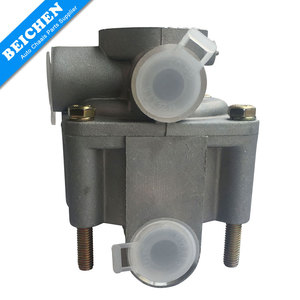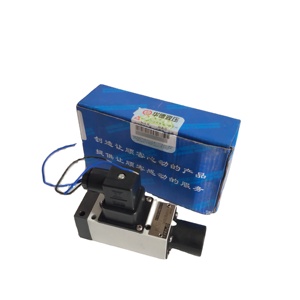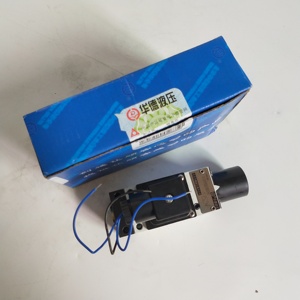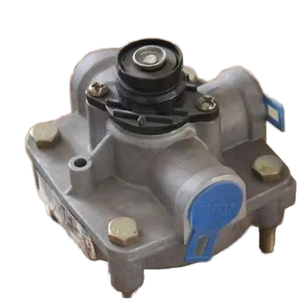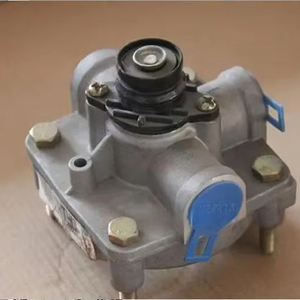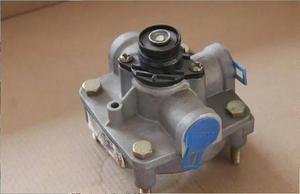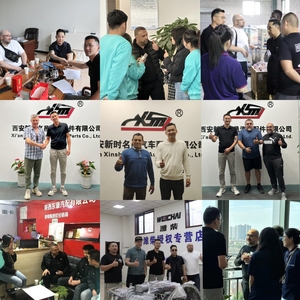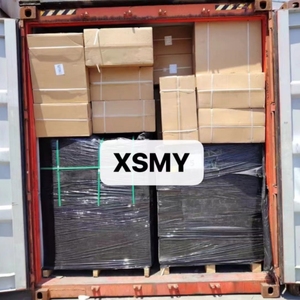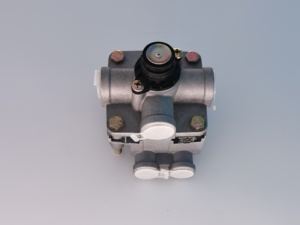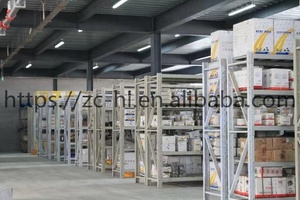Types of Differential Relay Valve
Differential relay valves are critical components in fluid control systems, designed to respond to pressure differences. Understanding the various types available helps in selecting the right valve for specific applications and operational requirements.
| Valve Type | Key Characteristics | Ideal Applications |
|---|---|---|
| Single-stage | Simple design, one-step processing | Straightforward operations, lower maintenance environments |
| Multi-stage | Complex signal processing, multi-sequence control | Precision applications, complex industrial systems |
| Electrically operated | Remote control capability, precise operation | Automated systems, integrated control networks |
| Pneumatically operated | Air pressure control, no electrical requirements | Hazardous environments, pneumatic systems integration |
| Manually operated | Direct control, no external power needed | Emergency systems, simple applications |
| Proportional | Variable control based on signal strength | Precision flow control, variable pressure systems |
| Zero differential | Activates at specific set point | Exact condition maintenance, critical thresholds |
| Time delay | Built-in activation delay | Systems with fluctuations, stabilization requirements |
Single-stage Differential Relay Valve
Processes signals in a single step without intermediate transformations. These valves excel in applications requiring direct, uncomplicated response mechanisms. Their streamlined design minimizes maintenance needs while maximizing reliability and operational longevity.
Best for: Systems requiring straightforward control logic and minimal complexity
Multi-stage Differential Relay Valve
Employs sequential signal processing through multiple stages before executing the final action. This design enables complex control sequences and precision adjustments, making these valves ideal for sophisticated industrial applications requiring nuanced response patterns.
Best for: Complex industrial processes requiring precise sequential control
Electrically Operated Differential Relay Valve
Features electronic control mechanisms allowing for remote operation and integration with digital control systems. These valves provide excellent precision and can be programmed for automated operation according to specific parameters or incorporated into larger control networks.
Best for: Modern automated systems requiring digital integration
Pneumatically Operated Differential Relay Valve
Utilizes compressed air signals for actuation, eliminating the need for electrical components. This design is particularly valuable in hazardous environments where electrical sparks pose safety risks. These valves integrate seamlessly with existing pneumatic control systems.
Best for: Explosive environments and pneumatic system integration
Expert Tip: When selecting between single-stage and multi-stage differential relay valves, consider not only your current operational requirements but also future system expansions. Multi-stage valves offer greater flexibility for system growth but come with increased maintenance complexity.
Specifications & Maintenance of Differential Relay Valve
Key Specifications
The predetermined pressure differential at which the relay activates. This critical parameter determines when the valve will operate based on the difference between two measured pressure points. Typically adjustable within a specified range and expressed in psi or bar.
The highest pressure differential the valve can safely handle without damage or performance degradation. Operating beyond this threshold can compromise valve integrity and system safety, potentially leading to catastrophic failures.
The differential between activation and deactivation pressure points, creating a buffer zone that prevents rapid cycling. This specification is crucial for system stability and extending component life by reducing operational wear.
The minimum pressure differential change required to trigger valve operation. Lower values indicate higher sensitivity and more precise control capabilities, making this specification particularly important for precision applications.
The materials used in valve fabrication determine its corrosion resistance, durability, and suitability for specific environments. Common options include brass, stainless steel, and specialized polymers for challenging conditions.
Maintenance Requirements
Conduct visual examinations at scheduled intervals to identify early signs of wear, damage, or leakage. Check mounting hardware for proper tightness and verify all connections remain secure. Document any unusual conditions for trend analysis.
Perform periodic cleaning using non-abrasive methods to prevent contaminant buildup. Use a damp cloth with mild detergent for exterior surfaces while avoiding harsh chemicals that could compromise seals or surface treatments.
Regularly verify proper operation using calibrated pressure testing equipment. Confirm the valve activates and deactivates at the correct pressure differential settings according to specification requirements.
Perform periodic recalibration to maintain accuracy of pressure differential settings. Use certified pressure standards and follow manufacturer's calibration procedures to ensure optimal performance.
Replace worn components promptly using only manufacturer-approved parts to maintain system integrity. Keep common replacement parts in inventory to minimize downtime during maintenance operations.
| Maintenance Task | Frequency | Tools Required | Importance |
|---|---|---|---|
| Visual inspection | Monthly | Flashlight, inspection mirror | High |
| External cleaning | Quarterly | Soft cloth, mild detergent | Medium |
| Functional testing | Semi-annually | Calibrated pressure gauge, test equipment | Critical |
| Calibration check | Annually | Calibration kit, pressure standards | Critical |
| Seal replacement | Every 2-3 years or as needed | Seal kit, specialized tools | High |
Important Safety Notice: Always depressurize systems completely before performing maintenance on differential relay valves. Failure to properly isolate and depressurize the valve can result in serious injury or equipment damage.
How to Choose Differential Relay Valves
Selecting the appropriate differential relay valve requires careful consideration of multiple factors to ensure optimal performance, reliability, and compatibility with your specific application requirements.
Application Requirements
Thoroughly analyze the specific needs of your system, including fluid type, operating temperature range, and pressure conditions. Different applications demand different valve characteristics for optimal performance and safety.
Size & Compatibility
Select a valve with dimensions that match your pipeline specifications and existing system components. Proper sizing ensures efficient flow control and effective sealing without requiring extensive system modifications.
Performance Specifications
Verify that the valve's differential pressure range and operating parameters align with your application requirements. A valve with appropriate performance specifications will provide reliable and accurate service throughout its operational life.
Material Selection
Choose construction materials suitable for your specific environment and media. Stainless steel offers excellent corrosion resistance for harsh conditions, while brass provides good performance in less demanding applications.
Quality & Manufacturer Reputation
Source valves from established manufacturers with proven track records for reliability and quality. Research customer reviews and seek recommendations from industry professionals to identify reputable suppliers.
Maintenance Requirements
Consider the long-term maintenance needs and accessibility of internal components. Select valves designed for easy servicing with readily available replacement parts to minimize downtime during maintenance.
| Selection Factor | Consideration Points | Impact on Performance |
|---|---|---|
| Cost effectiveness | Initial price vs. long-term reliability and maintenance costs | Affects total cost of ownership and return on investment |
| Installation complexity | Ease of integration with existing systems | Impacts installation time, costs, and potential system downtime |
| Functional capabilities | Automation level, control options, and adaptability | Determines operational flexibility and system integration potential |
| Warranty coverage | Duration, scope, and manufacturer support | Provides protection against manufacturing defects and premature failures |
| Industry certifications | Compliance with relevant standards and regulations | Ensures safety, quality, and regulatory compliance |
Purchasing Tip: When comparing differential relay valves from different manufacturers, create a standardized evaluation matrix that weighs factors according to your specific priorities. This systematic approach helps ensure objective comparison and selection of the most suitable valve for your application.
How to DIY and Replace Differential Relay Valve
Replacing a differential relay valve can be accomplished as a DIY project with proper preparation and understanding of the installation process. Follow these step-by-step instructions for a successful valve replacement:
Document the specifications of your existing valve including make, model, size, and pressure ratings. Ensure the replacement valve is fully compatible with your system's requirements and physical configuration. Confirm that connection types and dimensions match your piping system to avoid modification needs.
Assemble all necessary tools before beginning, including adjustable wrenches, screwdrivers, Teflon tape or thread sealant, socket set, and any specialized tools recommended by the manufacturer. Have replacement gaskets and seals ready if not included with the new valve.
Shut off the fluid supply and completely depressurize the system. Drain all fluid from the lines where you'll be working. Tag and lock out any energy sources to prevent accidental system activation during maintenance.
Carefully disconnect any control lines or electrical connections, labeling them for easy reconnection. Loosen and remove mounting hardware, keeping track of the orientation and position of all components. Extract the old valve while protecting the connecting pipes and fittings from damage.
Clean all connection surfaces thoroughly to remove old sealant, debris, and corrosion. Inspect connecting pipes and fittings for damage that might affect the new installation. Replace any damaged components before proceeding.
Remove protective coverings from the new valve. Apply appropriate thread sealant or install new gaskets as required. Position the valve in the exact orientation as the original, ensuring proper flow direction alignment. Secure all mounting hardware, tightening to manufacturer specifications in the recommended sequence.
Reattach all control lines, electrical connections, and accessories according to your previously created labels or documentation. Verify all connections are secure and properly seated before system pressurization.
Gradually restore system pressure while checking for leaks at all connection points. Monitor valve operation through several cycles to ensure proper functioning. Verify that the valve activates at the correct differential pressure settings.
Safety Warning: Never attempt to install or replace a differential relay valve without proper system depressurization. Always follow lockout/tagout procedures to prevent unexpected system energization during maintenance activities.
Installation Tip: Take photographs of the original valve installation from multiple angles before removal. These reference images can be invaluable when positioning and orienting the new valve, especially in complex piping arrangements.
Frequently Asked Questions
A relay valve functions as a differential pressure control device that uses pressure differences as its control signal and operates without direct mechanical connection to the controlled medium. It amplifies control signals to manage larger downstream functions. In contrast, a brake valve primarily controls the flow direction and rate of the medium but doesn't monitor or respond to pressure differentials. Brake valves typically have direct mechanical connections to control elements and focus on regulating flow rather than sensing system conditions.
A failing differential relay valve typically manifests through several observable symptoms:
- The controlled process generates alarm signals indicating abnormalities in the monitored parameters
- Inconsistent operation where the valve doesn't activate at the expected pressure differential
- Visible leakage around valve seals or connections
- Unusual noises during operation, such as chattering or knocking
- Slow or sluggish response to changing pressure conditions
- Complete failure to operate despite proper control signals
Note that the specific alarm signals may not always directly indicate the relay as the problem source, making systematic troubleshooting necessary.
Yes, differential relay valves can often be repaired rather than replaced, particularly for minor issues. Common repairable components include seals, gaskets, springs, and diaphragms. However, economic considerations should guide the repair-versus-replace decision. When repair costs approach 50-70% of a new valve's price, or when the valve has suffered severe internal damage, replacement is typically more cost-effective. Additionally, consider the valve's age, availability of replacement parts, and the criticality of the application when making this determination.
No, differential relay valves vary significantly across multiple dimensions:
- Size and capacity: Available in various dimensions to accommodate different flow requirements
- Pressure ratings: Designed for specific operating pressure ranges
- Materials: Constructed from different metals and composites based on application needs
- Control mechanisms: May utilize electrical, pneumatic, or manual actuation
- Design complexity: Range from simple single-stage to complex multi-stage configurations
- Application specialization: Optimized for specific industries and operating environments
While all differential relay valves share the fundamental purpose of responding to pressure differences, their specific designs, capabilities, and suitable applications vary widely. Selecting the appropriate valve requires careful matching of specifications to system requirements.



